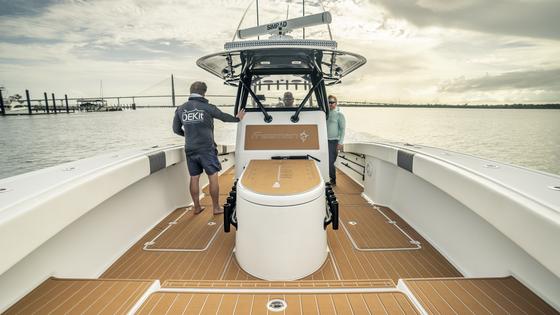We speak to one of the DEKit founders, Jeff Brauser, about how the right boat flooring will protect and enhance your vessel.
Buying a boat is a big accomplishment, and it only makes sense that you want your vessel to be in pristine condition for as long as possible. Boat flooring is an essential part of preserving your boat and adding value to it — the right type of flooring improves both the functionality and appearance of your boat.
If you’re in the market for boat flooring but not sure where to start, we’re here to help. DEKit is one of the leading boat flooring companies in the country and we spoke to Jeff Brauser, COO of DEKit, to get the inside scoop on all things boat flooring.
Boat Flooring Materials: Which One Should I Buy?
There are many types of boat flooring made from materials such as vinyl, wood, rubber, carpet or composite materials. Composite materials polyethylene (PE) foam and ethyl vinyl acetate (EVA) are particularly popular, and DEKit sells a polyethylene ethyl vinyl acetate blend which is incredibly durable. “We take the best of both worlds and combine it with a completely closed cell foam which has allowed us to make the best product possible,” says Brauser. The material is extremely dense and
ready to withstand the elements.
What Type of Boat Flooring Does My Boat Need?
Many boat owners suit their flooring to how they use their boat. Fishing boats require non-slip flooring, watersport boats require materials resistant to water damage and wear and tear, while leisure boats are focused on comfort. DEKit flooring can cover all activities and climates, whether you have a small boat in the marshes of Louisiana or own a 180-foot super yacht. Their exclusively cross-linked PE/EVA foam flooring is UV and oil-resistant, non-absorbent, and anti-slip, giving you reliability and performance whether you’re going deep-sea fishing or spending time island hopping.
Boat flooring should be treated as an investment, and with the right purchase, you will be happy for a long time. “Treat your boat like you would want to treat your home,” says Brauser.
How to Install Boat Flooring
The installation process for boat flooring will match the material you choose. For wood flooring, you will need to cut the pieces to size and attach them to your boat’s deck. Carpet, vinyl and foam flooring can be attached with adhesives or snaps. Composite materials can require screws to secure them to your boat’s deck.
The DEKit flooring installation is a breeze for owners; on the website click on the dealer locator tab and add your address which will connect you the closest supplier. Once you’ve contacted them, they will digitize the boat, creating a 2D rendering and a colored proof for you as a customer. This proof is very important as it's going to show the color, the design, the logo placement, the ruler placement, and anything else to ensure you’re getting exactly what you want. Once the measurements are finalized, the dealer will come and install on location. You don’t have to travel anywhere.
How to Protect and Clean Your Boat Flooring
Depending on your location and how your boat is docked, your vessel can be exposed to salt water, dirt, and the sun, all of which can wear down your flooring over time. It’s very important to regularly maintain your boat flooring to help it look it’s best and to preserve the materials, it’s made of. Carpet, vinyl, and foam flooring should be spot cleaned as needed. Composite materials should be washed and swept on a regular basis to remove debris and build up. Be careful with harsh chemicals and power washing your flooring and check first what it can sustain without damage.
Another way to protect your flooring is by simply covering it. Buying a boat cover is a sound investment and is a great way to extend your boat’s pristine condition. Boat covers can be made to suit your boat’s exact dimensions and everyday needs.
Boat flooring is an essential component of your vessel and there’s a wide variety of materials to choose from. DEKit’s custom-made flooring uses durable and weather-resistant materials that you will love for years to come.









